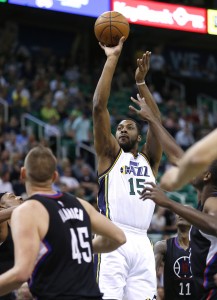The NBA’s current Collective Bargaining Agreement is designed to give teams certain benefits when it comes to re-signing their own free agents. Many players who reach free agency, for instance, are permitted to get 7.5% annual raises from their own teams, while they can only get 4.5% raises from another team. More notably, Bird rights free agents can sign five-year contracts with their own teams, but can only go up to four years with other clubs.
In some cases, that extra year doesn’t make much of a difference. Al Horford left Atlanta for Boston and signed a four-year contract with the Celtics, even though there were reports suggesting the Hawks were open to going to five years (albeit not quite for the max). Kevin Durant signed with the Warriors on a two-year contract that he’ll likely opt out of after the first year in order to maximize his future earnings.
Still, for at least a handful of players, that five-year contract appears to have played a part in their decisions to return to their own teams. As our Free Agent Tracker shows, six free agents signed five-year deals this year, and all six of those contracts were worth at least $85MM. Three of them were maximum-salary pacts.
Here are those five-year contracts, which will run through the 2020/21 season:
- Mike Conley (Grizzlies): Five years, $152,605,578 (partial guarantee in year five)
- DeMar DeRozan (Raptors): Five years, $137,500,000 (player option in year five)
- Andre Drummond (Pistons): Five years, $127,171,313 (player option in year five)
- Bradley Beal (Wizards): Five years, $127,171,313
- Nicolas Batum (Hornets): Five years, $120,000,000 (player option in year five)
- Evan Fournier (Magic): Five years, $85,000,000 (player option in year five)
Although Conley drew significant interest from the Mavericks, he was always a favorite to return to the Grizzlies, and none of the other five players on this list were seriously linked to another suitor, which is interesting.
Drummond and Beal were restricted free agents who got max deals, so there was never any suspense about their destinations, but plenty of teams would have been interested in prying away DeRozan from the Raptors, Batum from the Hornets, or Fournier from the Magic. The fact that those players’ teams were willing to offer five years likely made negotiations much simpler, since no rival suitor could offer that fifth year.
A five-year contract provides additional long-term security for free agents, and also gives the team the opportunity to give the player some agency as well. In four of the six deals listed above, the contract features a fifth-year player option.
That means DeRozan, Drummond, Batum, and Fournier have a safety net for that 2020/21 season — if they’re still playing at a high level at that point, it might make sense to opt out and sign a new longer-term contract. If their production has slipped, or if they’re battling injuries, they’ll have the option of remaining in their current contract and collecting a big pay check in that fifth year.
The ability to offer an additional year to their own free agents hasn’t always prevented teams from losing top-tier players on the open market, but there are still plenty of instances where that fifth year seems to make a difference. As the CBA opt-out date nears and the NBA and NBPA explore potential changes to their current agreement, it makes sense for this aspect of the CBA to remain unchanged. That extra long-term security may not appeal to every marquee free agent, but it does give a player’s current team a leg up, which is crucial if the league is worried about potential imbalance.
